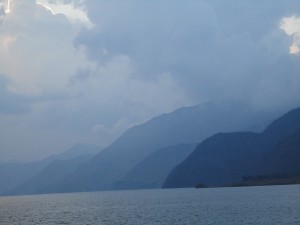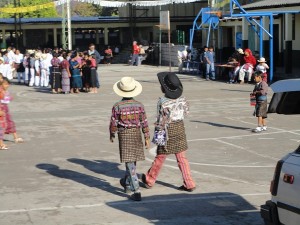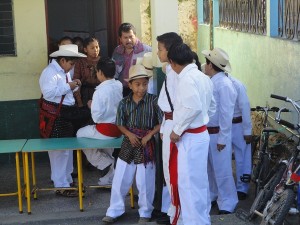By fortunate accident, we were in Panajachel on Monday, February 20, the festival day of Tecun Uman, a national hero in Guatemala. The honor seems bittersweet: K’iche leader Tecun Uman was slain in battle by Spanish conquistador Don Pedro de Alvarado, who had allied himself with the native Kaqchikel, enemies of the K’iche people. Tecun Uman’s death signified the end of autonomous rule by indigenous peoples in Guatemala. Here’s a snip from the New World Encyclopedia.
Tecún Umán (Tecún Umaán, Tecúm Umán, Tecúm Umam, or Tekun Umam) (c. 1500 – December 20, 1524) was the last ruler and king of the K’iche-Maya people, in the highlands of what is now Guatemala. According to the Kaqchikel annals, he was slain by Spanish Conquistador Don Pedro de Alvarado while waging battle against the Spaniards in the grasslands of El Pinal (Valley of Olintepeque) on February 20 1524. Tecún Umán is considered the most representative of his people for his bravery and dignity because he fought to protect his land and his people.
In the middle of November of 1523, the Estremaduran captain Don Pedro de Alvarado y Contreras had been sent on an important mission by Hernán Cortés to discover and conquer the lands south of Mexico. For this journey, Alvarado was given three hundred soldiers, a hundred and twenty archers and gunmen, one hundred and thirty five horsemen, and several hundred Cholutec and Tlaxcaltec allies… Alvarado allied himself with the Kaqchikel, who had long been bitter rivals of the K’iche’ nation.
***
The legends say Tecún Umán entered battle adorned with precious quetzal feathers, and his nagual (animal spirit guide), also a quetzal bird, accompanied him during the battle. In the midst of the fray, both Alvarado and Tecún, warriors from worlds apart, met face to face, each with weapon in hand. Alvarado was clad in armor and mounted on his warhorse. As horses were not native to the Americas and peoples of Mesoamerica had no beasts of burden of their own, Tecún Umán assumed they were one being and killed Alvarado’s horse… He quickly realized his error and turned for a second attack but Alvarado’s spear pierced through his opponent’s chest and into his heart. It was then his nagual, filled with grief, landed on the fallen hero’s chest, staining its breast feathers red with blood, and thereafter died. From that day on, all male quetzals bear a scarlet breast and their song has not been heard since. Further, if one is to be placed in captivity, it would die, making the quetzal a symbol of liberty.
Tecún Umán was declared a National Hero of Guatemalan on March 22, 1960 and is celebrated annually on February 20… He is also memorialized in a poem by Miguel Ángel Asturias that bears his name. In contrast to his popularity, he is at times rejected by Maya cultural activists who consider his status as a national hero a source of irony, considering the long history of mistreatment of Guatemala’s native population.
The children in one of the schools in Panajachel commemorated the day with a dance and parade, shown in the photos below. Here in Guatemala, so many indigenous people continue to struggle for basic sustenance–enough food, clean drinking water, a secure roof over their head, a permanent floor under their feet. The effects of Tecun Uman’s defeat linger.







 ShareThis
ShareThis